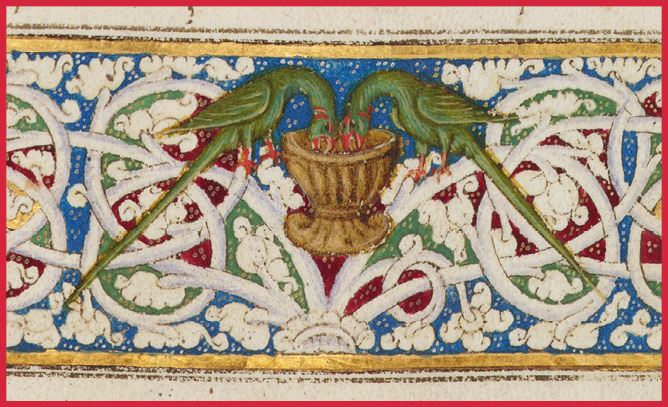This article is taken from PN Review 277, Volume 50 Number 5, May - June 2024.
Pictures from the Rylands Library
A Pandemonium of Parrots in Latin Manuscript 53

It is easy to see why a bibliomaniac of William Morris’s stamp – fuelled, though he was, by a compulsion to fund and further the cause of socialism – would be bereft the moment he sold his copy of Prolianus’ Astronomia. For this manuscript, which treats the subject of the constellations in their celestial sphere in gold leaf and the sparkling colours of many a semi-precious stone, would add star quality to even the most stellar of bibliographical collections.
Probably commissioned by Cardinal Giovanni of Aragon between 1478 and 1480 at the court of his father Ferdinand I of Naples, a familial cluster of bibliophiles famous for their patronage of the arts of the book, this manuscript has sometimes been claimed to be the work of the ‘librarius et miniator’, Gioacchino de Gigantibus. Gioacchino was born in Bavaria but trained in Florence’s workshop system. His skills as a scribe and illuminator took him on peregrinations throughout Italy, from the Rome of the 1450s to Siena, then on to Naples and finally back to Rome, where he disappeared from sight in 1485. Ever in demand amongst the aristocracy, he also worked by appointment to six popes as well as numerous high-ranking church officials. And while some may challenge the attribution of the Rylands Astronomia to his oeuvre, this little book carries all the hallmarks he popularised beyond Florence in ‘extremely recognisable fashion’ (M. Buononcore). Take, for example, the use made throughout the book of ‘bianchi girain’ or white vine stem decoration, picked out on a ground of lapis, vermillion, verdigris and gold. Or the array of creatures including, most prominently, a pandemonium of emerald parrots with ruby-red beaks, legs and claws found inhabiting its branches. Presented in pairs, facing each other as mirror images, these flamboyant popinjays were a key component of Gioacchino’s decorative repertoire, and likely parroted by the many imitators that sought to mimic his idiom.
But what’s with this penchant for parrots, whose prominent presence seems at odds with a humanist astronomical text? What Quattrocento symbolic affinities permit them to frolic amongst the all’antica forms of the Cardinal’s exquisite book? Regarded as miraculous beings and emissaries of paradise within the Catholic tradition, parrots were once seen as ‘marvels worthy of wonder and veneration… associated with prophesy, purity and sacred geography’ (Bruce Thomas Boehrer). Their ability to speak, recite prayers and even ape (or parrot) human gestures appeared to show their capacity to engage in meaningful conversation, thereby ‘elevating them in the hierarchy of creation’ (Tony Juniper). Their exalted position in the chain of being was in turn reflected in their place in the cosmic order, for in the 1480s what happened on Earth was mirrored in the Heavens. Sad to say it was through the Protestant rejection of the miraculous that the parrot was eventually knocked off its perch to become ‘trivial, ordinary, even annoying, and in danger of becoming extinct’ (Boehrer). But in the realm of our Cardinal’s book they ‘leap off the page with special exuberance’ (Boehrer), having found their own true home.
Detail of parrots from Prolianus’ Astronomia, Latin Manuscript 53, 1478. (© Image provided by The John Rylands Research Institute and Library, The University of Manchester, 2024)
This article is taken from PN Review 277, Volume 50 Number 5, May - June 2024.
